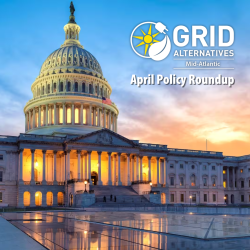Climate financing is having a moment.
With $20 billion in federal grants announced this month, the Inflation Reduction Act (IRA) is taking shape as the game-changer it was designed to be. Maryland and Virginia are following suit in the Mid-Atlantic region. There’s a lot to get to, so let’s dive right in!
District of Columbia
It’s budget season in the District! Unfortunately, the city’s current financial situation means that the Mayor and Council are negotiating several cuts. Although the GRID Mid-Atlantic-supported Healthy Homes Act (B25-0019) moved forward unanimously in the Council earlier this month, the current budget proposal threatens funding set aside last year in the Sustainable Energy Trust Fund (SETF) in support of helping income-qualified Washingtonians swap out polluting gas appliances for healthier and safer electric versions. We urge the Council to restore this funding and prioritize equity throughout its appropriations processes, especially as they relate to energy and housing.
Maryland
In better news: Maryland’s 2024 legislative session ended with some notable wins for equitable access to renewable energy.
The Brighter Tomorrow Act (SB 783) establishes a Customer-Sited Solar Program to provide Maryland Energy Administration (MEA) grants of $750 per kW of solar (up to $7,500) to income-qualified households, building on policy models that GRID has advanced in other states and DC. This Act also contains provisions to boost renewable energy credits for distributed solar AND promotes easier permitting.
Meanwhile, the DRIVE Act (SB 959), would enhance electric grid resilience by providing compensation for bi-directional EV charging and virtual power plants. These improvements can reduce the need for costly transmission and distribution grid upgrades that add to inequitable energy burdens. Some of these legislative advances have roots in the landmark 2022 Climate Solutions Now Act. We hope and expect that Governor Moore will sign these bills!
Even more exciting things are happening in some of our neighboring localities. In Montgomery County, for example, the recently proposed budget would add $9 million in new spending to further the County’s efforts to fight climate change, including helping lower-income residents access federal Inflation Reduction Act incentives for renewable energy. Finally, state regulatory agencies continue to build out Maryland’s electricity rates, community solar programs, and other elements of the state’s clean energy future.
Virginia
The legislative session and the governor’s approval/veto period have both passed in Virginia, and the General Assembly will reconvene on April 17 to consider the governor's actions on bills.
We’re applauding Governor Youngkin for signing into law two bills (HB 106/108) expanding shared solar programs, so those who cannot or do not wish to get solar on their roofs can still access solar savings. However, a bill (HB 1062) that would have clarified third-party ownership for solar systems—enabling more low- and moderate-income households access to renewable energy—remains in limbo as the legislature must consider storage-related changes proposed by the governor.
Governor Youngkin also did not sign a bill expanding solar consumer protections (HB 576) but recommended convening a work group for further study. Sadly, the governor proposed delaying the establishment of the Virginia Clean Energy Innovation Bank (SB 729) until 2025, threatening the Commonwealth’s access to federal Inflation Reduction Act funds. I’ll be speaking at the Virginia Solar Summit in Richmond in May, where these and other developments are sure to be hot topics.
Federal
Earlier this month, the EPA announced awardees for two programs in the Greenhouse Gas Reduction Fund (GGRF), a huge step for the allocation of the Inflation Reduction Act.
The National Clean Investment Fund (NCIF) distributed approximately $14 billion towards direct project investment to the Climate United Fund, Coalition for Green Capital, and Power Forward Communities. We’re very happy for Power Forward Communities, a coalition that includes several of our partners!
The Clean Communities Investment Accelerator (CCIA) distributed $6 billion to nonprofits for developing financial resources and technical assistance to build the climate lending capacity of community lenders. These funds must go toward “low- to moderate-income or disadvantaged communities.”
We’re eagerly awaiting an announcement on how the Solar for All program will allocate its $7 billion in funding, as GRID Alternatives has submitted two applications toward that grant.
This infusion of favorable financing will help solar, storage, microgrid, and clean mobility projects of all sizes happen more easily, and also presents opportunities for GRID's Energy Resilience Fund.
While there are many climate and environmental justice funds in IRA through an alphabet soup of agencies (EPA, DOE, DOI, USDA, DOT...), the mega-bill's other largest investment for equitable clean energy comes in the form of tax credits through the IRS. One of the largest is the Investment Tax Credit (ITC), which pays 30% of project costs after they're placed in service. "Elective pay" provisions in the IRA make these credits directly available to non-taxpaying entities like nonprofits, Tribes, churches, municipalities, and rural electric cooperatives for the first time, putting them nearly (though not quite) on a level playing field with for-profit clean energy developers.
IRA, along with the Bipartisan Infrastructure Law (our friends BIL and IRA!), really change the game for GRID's mission of advancing economic and environmental justice through community-led renewable energy. It's a testament to the work of everyone here proving the model and its impact every day.

